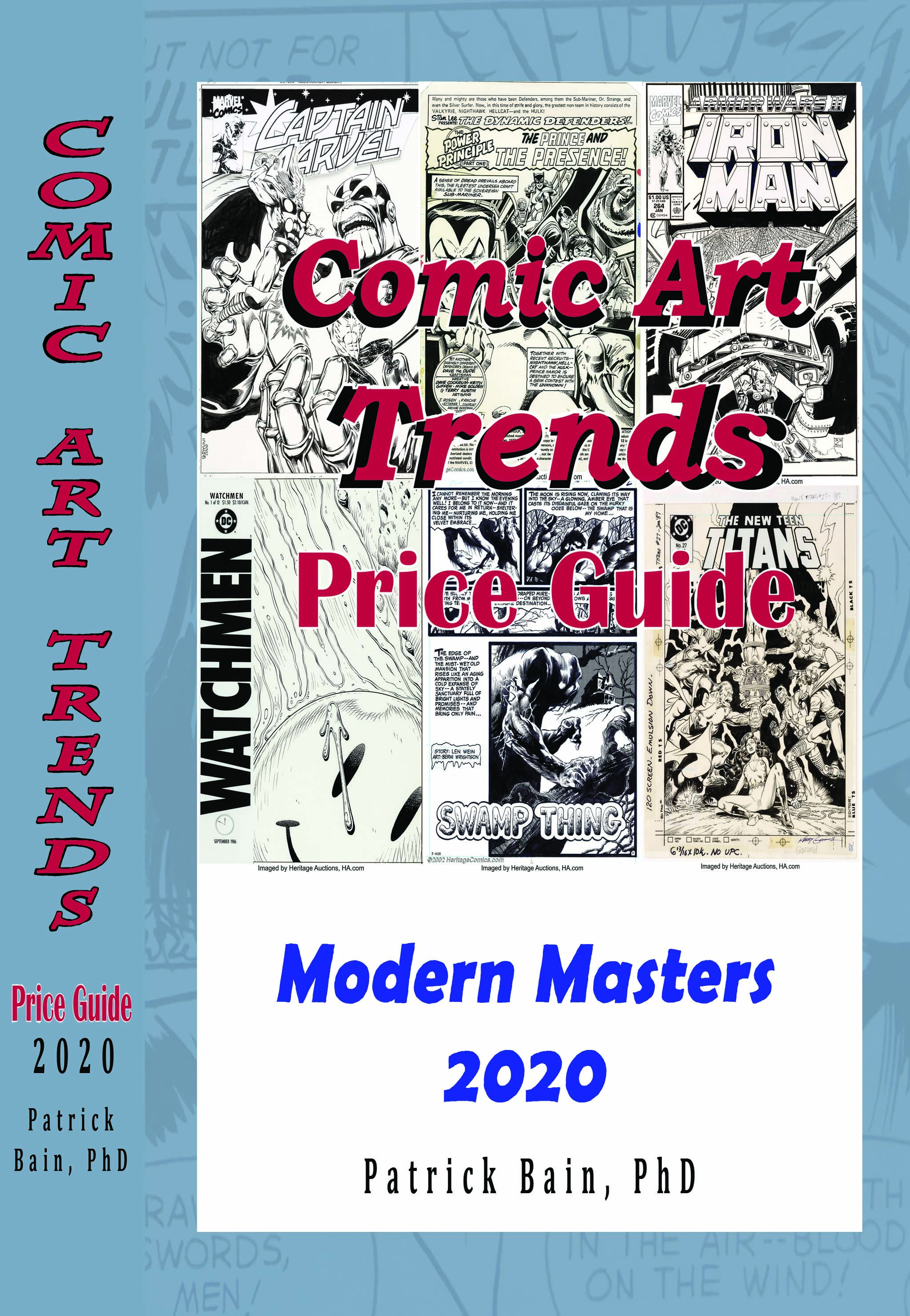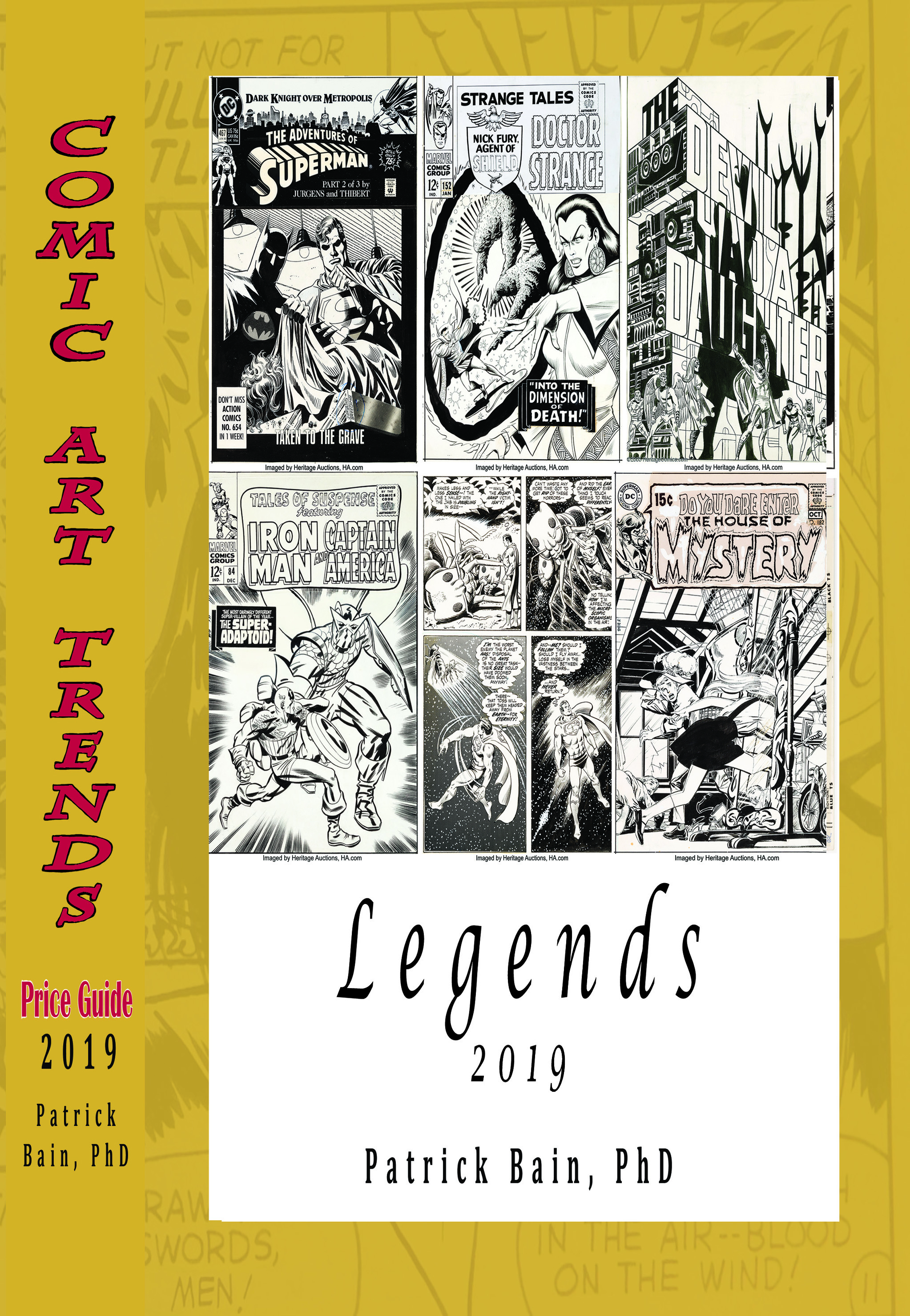
Trends in comic art sales for investors, hobbyists, dealers, and fans
Original Comic Art Trends Price Guide
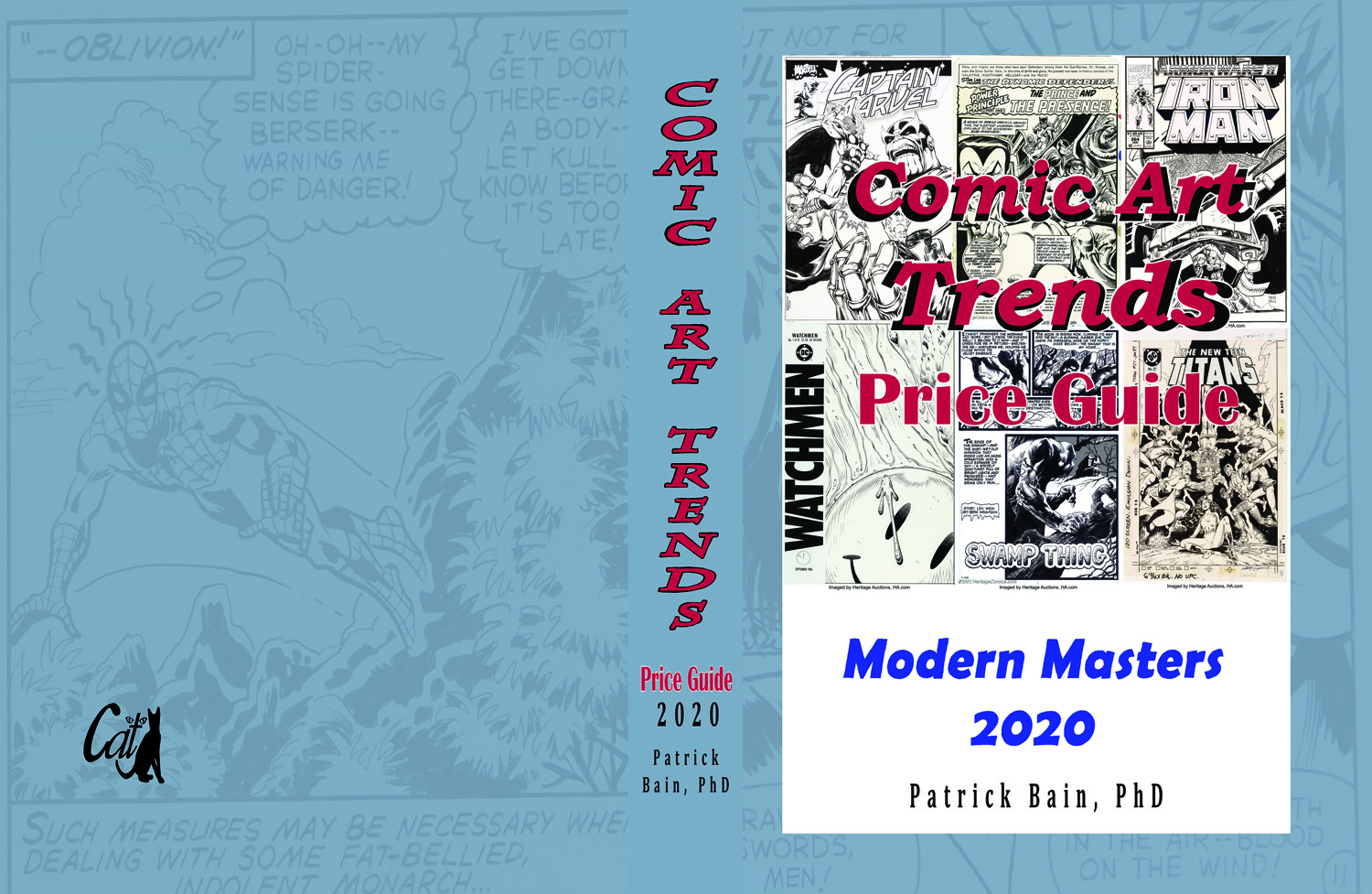 The Comic Art Trends Price Guide is the only reference book in the market for original comic book art. The Price Guide combines sales information for thousands of pages of original comic book art with unique graphical and market analysis. Besides hundreds of fun images of awesome original art, the Comic Art Trends Price Guide includes the proprietary CAT Scale grading system. Each page of original art (thousands of them) has been assigned a CAT grade. The CAT grade is a means for art buyers, sellers, investors, and hobbyists to group unique, original art for comparison purposes.
The Comic Art Trends Price Guide is the only reference book in the market for original comic book art. The Price Guide combines sales information for thousands of pages of original comic book art with unique graphical and market analysis. Besides hundreds of fun images of awesome original art, the Comic Art Trends Price Guide includes the proprietary CAT Scale grading system. Each page of original art (thousands of them) has been assigned a CAT grade. The CAT grade is a means for art buyers, sellers, investors, and hobbyists to group unique, original art for comparison purposes.
Original Comic Art Price Guide for 2024
In the latest article for the Comic Art Trends Price Guide, I review the phenomenom that is Sandman. This Sandman is the modern version rolled out by Neil Gaiman, Sam Kieth, and Mike Dringenberg. I've included market information, data and graphical analysis, and a veritable gallery of art by Kieth, Dringenberg, and more. This issue again provides many examples and descriptions of how I graded the art according to the CAT scale. I've also generated statistics for the Affordability Index and Extravagance index for both Dringenberg and Kieth.
Original Comic Art Price Guide for 2023 and Beyond
In 2023, I will roll out the revised editions based on the new grading scale. The editions will be broken down into issues, each focusing on an artist, a group of related artists, or a fun topic. Artists will include many from the Legends and Modern Masters editions, but not all. New artists will also be celebrated!
The following artists are planned for the 2023 Editions: Arthur Adams, Carl Barks, Wayne Boring, Bob Brown, Ramon Fradon, Bob Kane, Werner Roth, Joe Shuster, Joe Simon, Dick Sprang, and Alex Toth. Other modern artists will be added as I go.
Up first: I recently bought several old Tarzan comics from the late 40s and 50s. I found out the long time artist on the series was Jesse Marsh. The new found interest led me to put together an article celebrating Marsh along with a host of other phenomenal Tarzan artists. Download the pdf for free and see if any of your favorite Jungle Lord artists are included.
New and Fun: the Affordability Index
In these times of rising prices at the gas pump, grocery store, and auction house... it's nice to know what a guy can afford these days. Particularly in the area of original comic art! The Affordability Index is a new invention of the CAT price guide that I recently rolled out. With the CAT price guide, I focus on PUBLISHED original comic art. For purposes of affordability, I simply asked the question--what can I get for $500, $1,000, $5,000, and so forth. We all have different depths of pocket books when it comes to our collectibles. So, can I afford a convention sketch, an original page with no popular characters, a splash, etc. So far, I calculated the current values for Jim Lee, Jack Kirby, Sam Kieth, and Mike Dringenberg. But, it's easy to do and I provide all the necessary tools for you to do it yourself for ANY artist you are interested in.
More on the Price Guide for Original Comic Art
Have you thought about buying original comic art but you are afraid to make a mistake and pay too much? Do you have art to sell but don't know what people are getting for similar pages? How do you know what pages are similar?
The Comic Art Trends Price Guide is designed to arm people with information about original comic book art. Stock investors can find bit-buckets of information necessary to understand the market. Home buyers have millions of homes only a google away. Just as the Overstreet Comic Book Price Guide has opened up the market for comic book collectors for nearly fifty years, the Comic Art Trends Price Guide is creating a much needed service to new investors, collectors, and fans-- and solid information for the experienced collector and industry professional as well.
Whether your comic art interest is casual or you need a Brinks truck every time you make a purchase, the CAT Price Guide and system for scoring comic art is a useful and entertainiong tool to keep in your utility belt.
Here's the problem statement:
-
Original Art is one of a kind-- it's impossible to compare two or more pieces.
There are too few sales of comic art to see trends-- one rich collector with a childhood memory can blow up the price.
-
Thousands of copies of each comic book are printed-- how can a grade be assigned when art is unique?
-
Time period, artist, character... there's so many variables-- what are the truly important factors to focus on for original comic book art?
These are valid CHALLENGES... but the CAT Price Guide is all about overcoming the challenges of understanding the original comic art market!
What is the Comic Art Trends Price Guide?
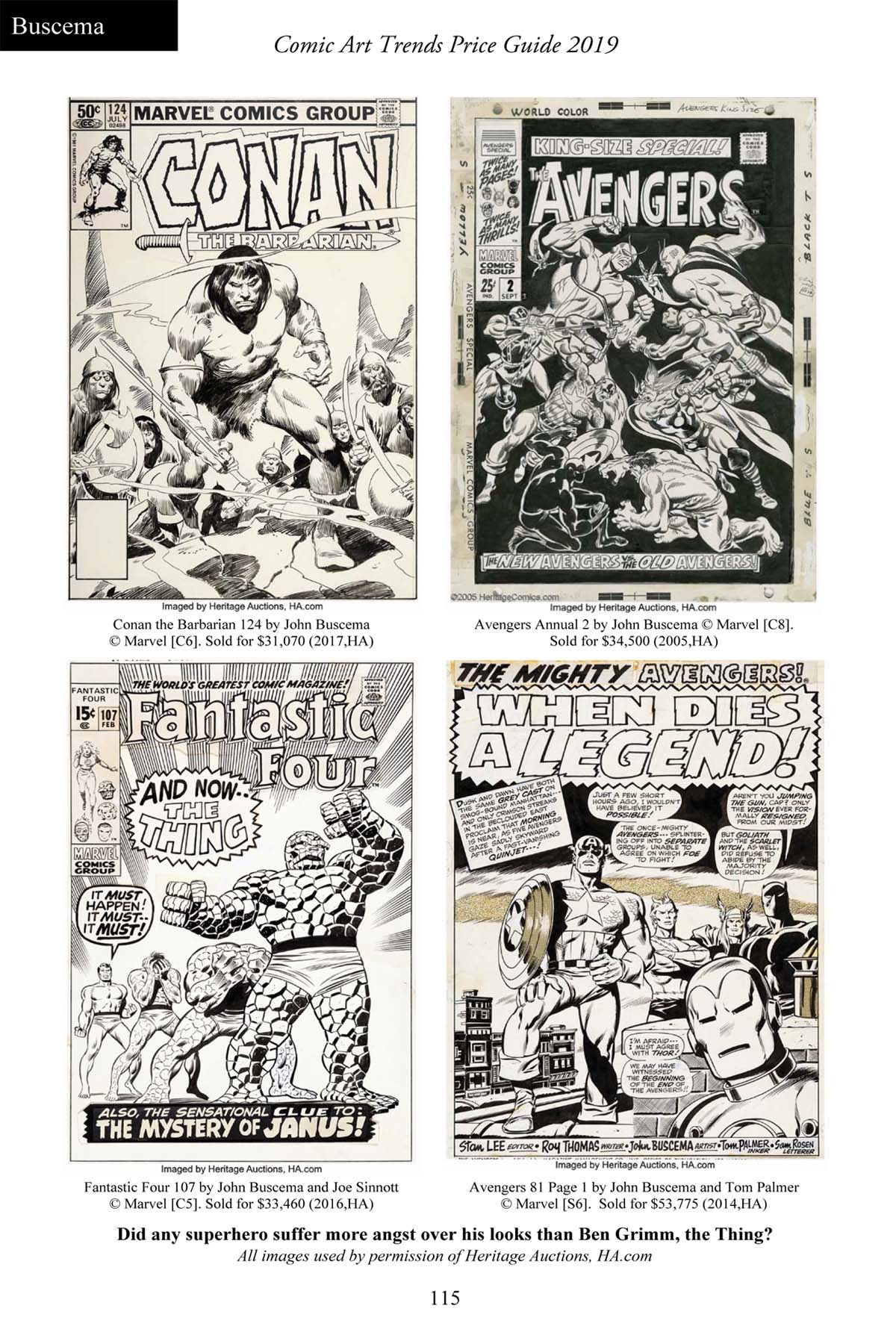
The CAT Price Guide is a multi-year partnership with fans and professionals to thoughfully answer questions related to sharing market data and deriving meaningful grading systems. The ultimate goal is not to hurt the professionals in the industry, but rather to strengthen the original comic book art industry for everyone. The first two editions of this unique guide to original comic book art catalogued tens of thousands of pages of art by about 70 artists. Check out the images below to see examples of the visual and analytical information in the Comic Art Trends Price Guide.
Naturally, it has to have pictures of some of the most fantastic comic art ever produced. Thanks to Heritage Auctions for permission to use their images! Each picture includes basic information such as the name(s) of the artist(s) and a description of the page. I also include info such as price and date sold. Of big value to the reader, I indicate the CAT score for each page. Looking at the provided examples in my book and social media outlets is a simple help to the reader who wants to learn how to differentiate artwork using the CAT Scale.
Features for Each Artist
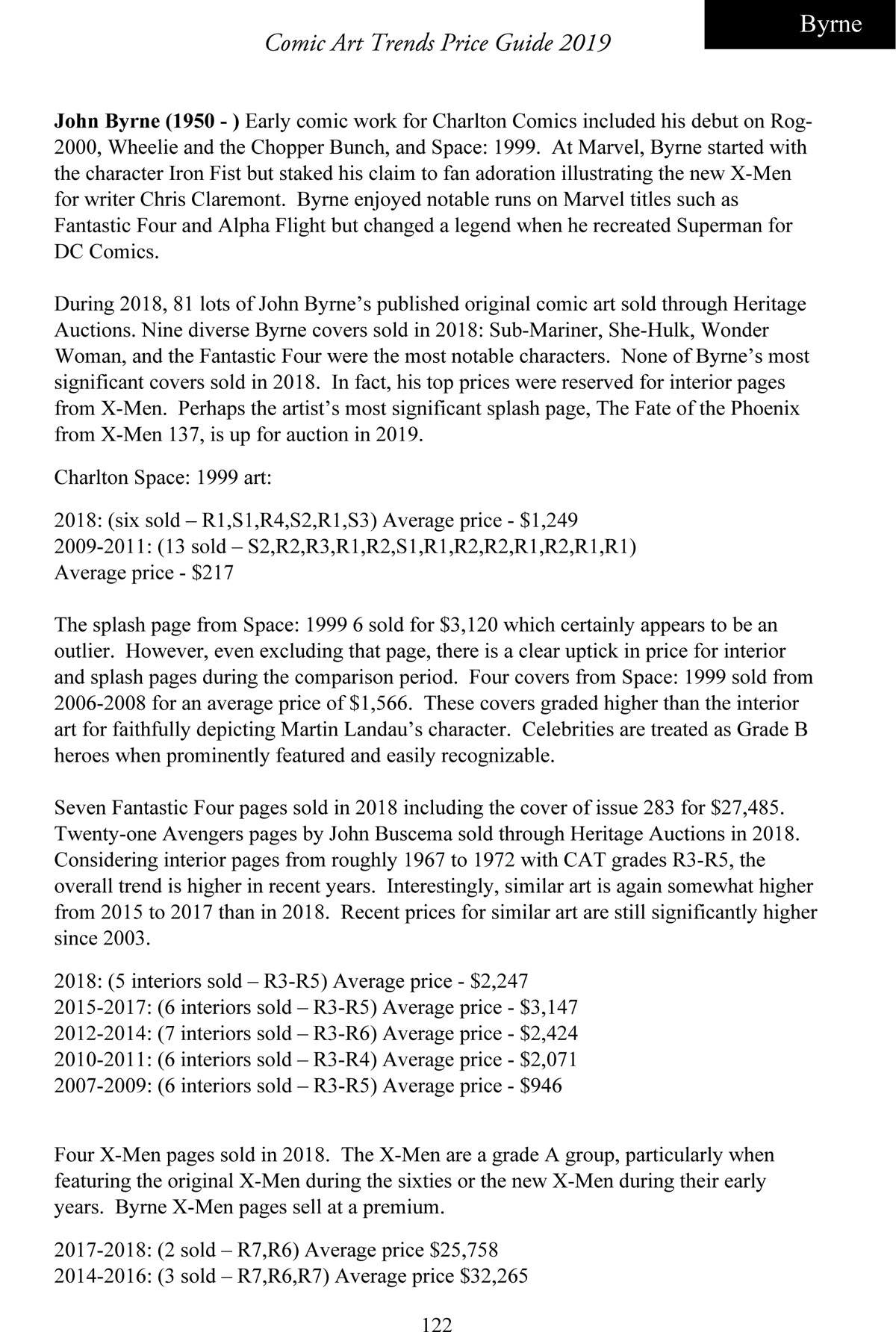
Each artist section begins with a summary of recent sales data through Heritage Auctions, ComicConnect, and ComicLink.
The market data provides the reader with a quick overview of recent sales. I point out comparisons I find interesting. Usually, there are a few phenomenal recent sales worthy of mention. This is where I express my thoughts on the market for the featured artist, but backed up by actual sales data.
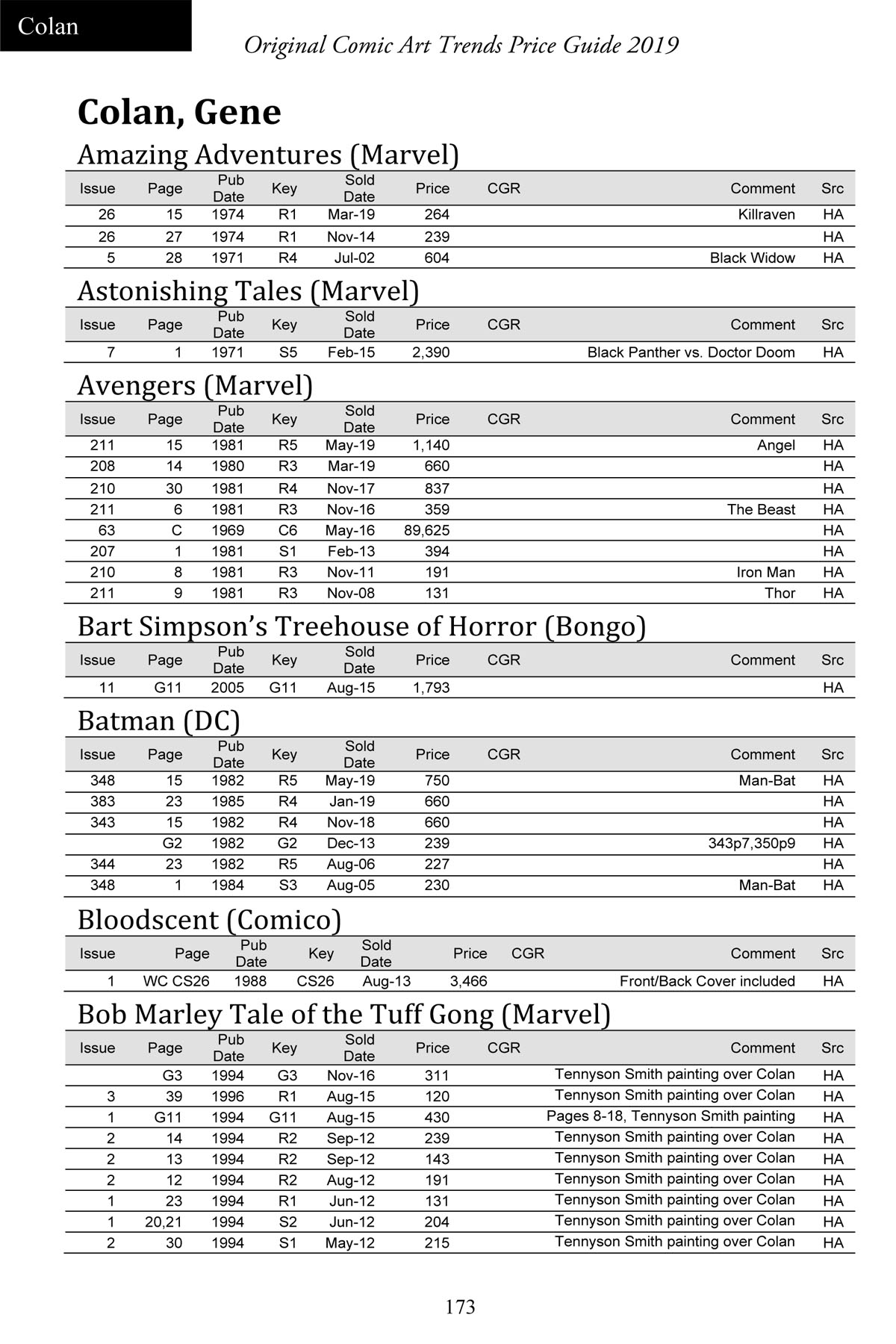
Each artist section is populated with tables of sales data. A separate table is included for each series title. The pages are ordered with newest sales listed first since those sales are most relevant from a current price perspective. Each page is identified by title, issue number, and location such as page 15 or "C" for Cover. Some pages came to market as a lot. Group sales or Complete Story sales are identified by Gx or CSx, where 'x' represents the number of pages. Other imporant information in the table includes the Publication Date, Sold Date, Price, Source of Sale, and sometimes a comment. The unique information only found in the CAT price guide is the CAT score. The CAT grading scale is REVISED and SIMPLIFIED. The 2023 downloads include discussion on the updated scale. The Grading Companion is currently OUT OF DATE, but I'll work on it when I get a chance. Download the first 2023 Edition for the updated grading guide. One other piece of information is the CGR (Compounded Growth Rate). This statistic is useful because it directly compares sales price for a particular page that has sold more than once.
Graphs are not just for Math Class
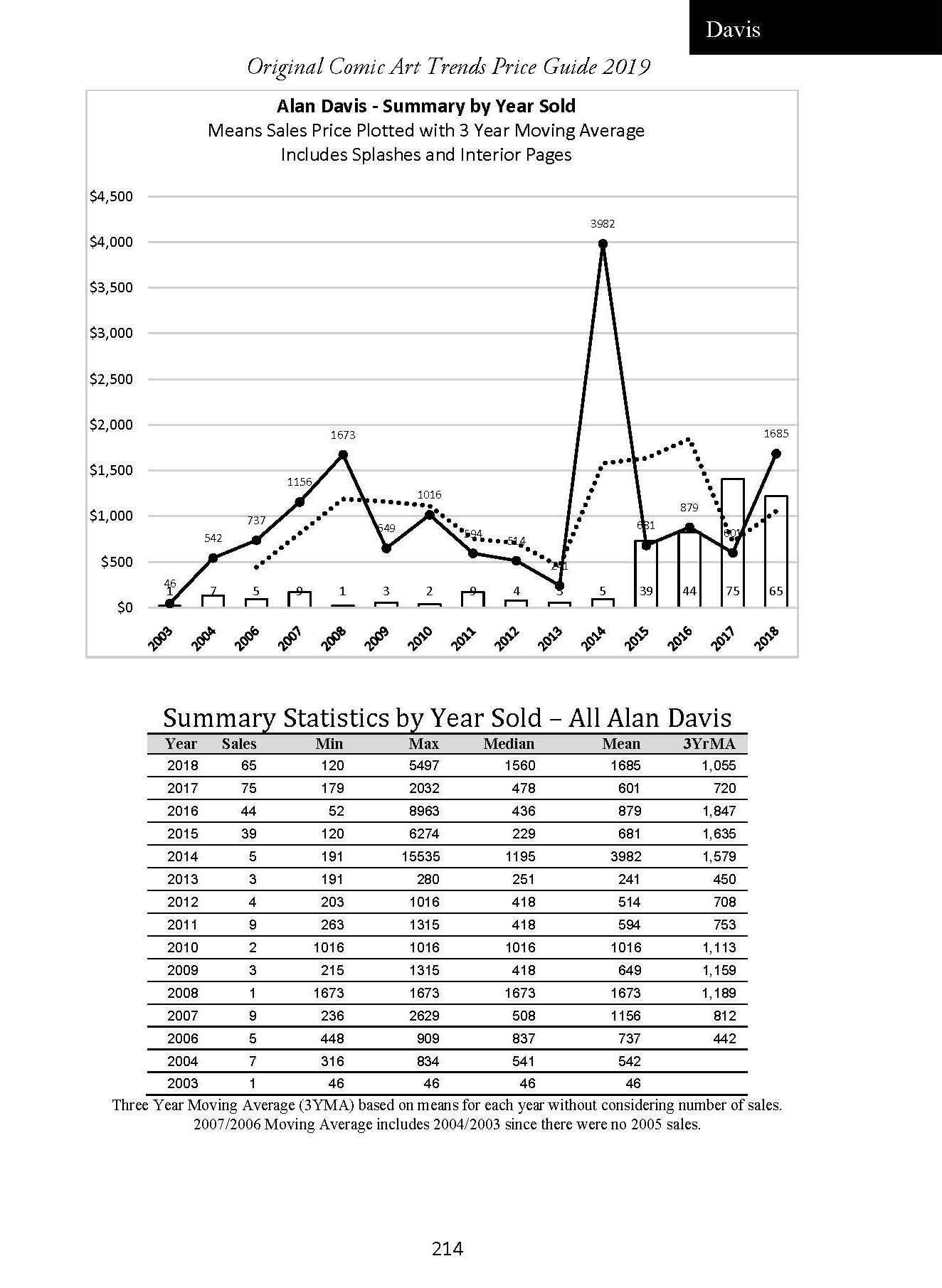
Graphs are visual tools to summarize data. Hundreds of sales can be captured in a single picture. I present three different forms of graphs in the Comic Art Trends Price Guide. Since there are so many factors that affect price and demand, it is not enough to show a bubble plot of sales. In fact, data must not only be viewed over time, but also according to grade. Here are the graphs I present for the original comic book art included in this book:
Summary data by year of sale (mean, median, minimum, and max)
Summary data by year published (includes analysis of the significant factors affecting sales price)
Summary data grouped by CAT score (mean, median, minimum, and max represented graphically)
The summary graph below depicts mean sales of pages by Alan Davis based on year sold. This graph excludes cover sales. A 3 Year Moving Average is superimposed over the graph as an aid to viewing the trend of the mean sales price. Moving averages are lagging indicators of the trend. They are not predictive in nature, but they help to balance out the one-time swings caused by outlier sales either on the high or low side.
The Art Universe is too Big
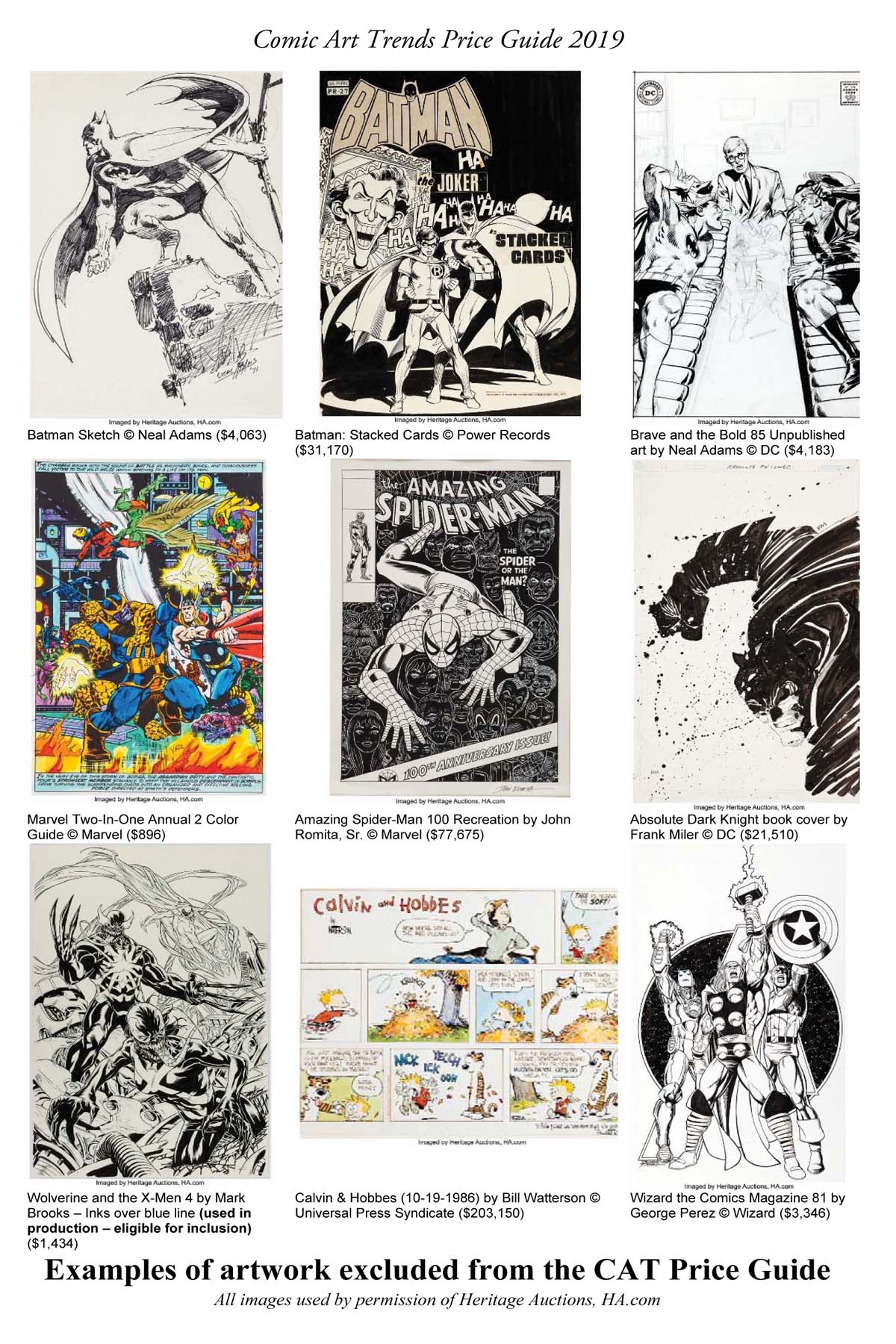
I purposely restrict the scope of art that is included in the Comic Art Trends Price Guide. The intention of the guide is to help differentiate pages of ORIGINAL, PUBLISHED, COMIC book art. There are many exceptional forms of art that are both collectable and investment worthy. However, the universe of art is huge and I can't do justice to any of it if every beautiful form of artwork is included in this one series of books. For example, sketches and various promotional art products are excellent collectibles, but not included in the price guide. The image below illustrates many of the types of art that are excluded.
Summary of what the Comic Art Trends Price Guide is all about
Just to pull it all together. The guide is organized by artists. In 2023 and beyond, I will release small "issues" for each artist as available rather than collecting them all into a 600+ page volume before release.Each artist issue features sales data by title, images from many significant works, and summary statistics with trend lines to gauge the market going forward. In addition to precise sales information, the guide includes a proprietary CAT score for each listing. The CAT score is a means to objectively compare multiple pages of art. Ultimately, the Comic Art Trends Price Guide is intended to provide information that is relevant to serious comic art investors and entertaing to any comic art geek.
I believe the information in the Comic Art Trends Price Guide will empower many more people to enter the market for original published comic book art.
For a moment let me not be subtle; the Comic Art Trends Price Guide offers an objective means to grade original comic book art with an emphasis on published art. I assert that the CAT scale is a valid means to compare two pages of comic art. If an artist you are interested in is not covered in the Comic Art Trends Price Guide yet, then use the same strategies described in my book to compare the artwork you are interested in.
All Artists featured in the Legends Edition 2019
The Comic Art Trends Price Guide 2019 is the first annual edition. This year's edition is called 'Legends' because it features many of the greatest artists in industry history. Most of these artists made their greatest contributions in the 1940s, 1950s, and 1960s. Some of the artists made prolific contributions in the seventies, eighties, and nineties, as well. The 2019 edition includes Neal Adams, Murphy Anderson, Ross Andru, Jim Aparo, John Buscema, John Byrne, Ernie Chan, Gene Colan, Alan Davis, Dick Dillin, Steve Ditko, Bill Everett, Jose Luis Garcia-Lopez, Joe Giella, Dick Giordano, Carmine Infantino, Dan Jurgens, Gil Kane, Jack Kirby, Joe Kubert, Jim Lee, Todd McFarlane, Frank Miller, Irv Novick, Tom Palmer, George Perez, Gordon Purcell, Fred Ray, Jerry Robinson, John Romita, Sr., Alex Ross, Joe Sinnott, Jim Steranko, Curt Swan, and Herb Trimpe. Some artists besk known as inkers are only listed in the inking section.
All Artists featured in the Modern Masters Edition 2020
The Comic Art Trends Price Guide 2020 is the second annual edition. This year's edition is called 'Modern Masters' because it features many of the modern masters whose works were largely produced in the 1970s, 1980s, and 1990s. The 2020 edition includes Dan Adkins, Alfredo Alcala, Terry Austin, Dick Ayers, Mark Bagley, Jerry Bingham, Brian Bolland, Brett Breeding, Frank Brunner, Rich Buckler, Sal Buscema, Nick Cardy, Dave Cockrum, Vince Colletta, Ron Frenz, Kerry Gammill, Dave Gibbons, Michael Golden, Mike Grell, Tom Grummett, Ed Hannigan, Don Heck, Klaus Janson, Michael Kaluta, Dale Keown, Alan Kupperberg, Bob Layton, Rob Liefeld, Ron Lim, Bob McLeod, Don Newton, Jerry Ordway, Keith Pollard, Marshall Rogers, John Romita, Jr., Mike Royer, Joe Rubinstein, Steve Rude, Alex Saviuk, Mike Sekowsky, Marie Severin, Marc Silvestri, Walt Simonson, Paul Smith, Jim Starlin, Lee Weeks, Barry Windsor-Smith, Wally Wood, Bernie Wrightson, and Mike Zeck. Some artists best known for their inking are only listed in the section on inkers.
How can I invest in comic art using the Comic Art Trends Price Guide?
First and foremost: I AM NOT YOUR INVESTMENT ADVISOR!!!
Please consult a professional or do your own due diligence before making any financial decisions.
That said, I created the Comic Art Trends Price Guide as a result of my own interest in making buying decisions. I wanted to better understand what a proper market price for a piece of original comic art might be. So while neither I nor the Comic Art Trends Price Guide can give you any investmest advice, I hope the information in my price guide will be a solid tool that you can use along with your own study of the original art market.
Here are some prudent pieces of wisdom that have stood the test of time.
1. Neither a borrower nor a lender be. I guess Shakespeare popularized that statement. If you have to borrow money or buy art using a credit card that isn't paid off each month, your risk and likelihood of a negative rate of return are dramatically increased. So, it is best to make sure you can afford the art before buying it.
The Comic Art Trends Price Guide shows many examples of CGR (compounded growth rate) that are negative. That is, a particular page of art sold a second time for less than its previous price. Most the time, the reduced price came when the art was sold a relatively short time after the first sale. Owing money on a piece of art might pressure the art-holder to sell sooner than planned.
2. Diversify. Solomon said to 'Divide your portion to seven, or even to eight, for you do not know what misfortune may occur on the earth.' Ecclesiastes 11:12. So you may not want to take your entire 401K and drop it on a purchase of a Frank Miller page from The Dark Knight Returns. Having all your money in the stock market could be equally bad.
The Comic Art Trends Price Guide shows many pages of art by many of the most respected artists in a wide range of prices. When sensibly done, there is nothing wrong with putting a small portion of your nest egg in high quality original art, just like you may want to buy a chunk of gold. Keep in mind, art and gold have the same fatal flaw, they are only worth what someone is willing to pay or offer in service for that object.
3. Buy Low, Sell High? How do I know if something is going up or down? The art market, like the stock market, tends to act as a group. Generally, when art is in demand it is good for all different kinds of comic art. Just as the best time to buy a stock is during a Bull market because the market as a whole is going up, even the best stocks typically go down when the market as a whole goes down. For great information on the stock market, I wholeheartedly support Investors Business Daily. To my knowledge the type of data they collect for stocks, does not exist for original comic art.
The Comic Art Trends Price Guide has a goal of attempting to capture trending market data. These editions are just a first baby step. With over four years to reflect on the market and grading, the principles of the scale are sound. And they should be, since they only have value to the extent that they align with what art collectors intuitively know. Use the limited number of artists and works included so far as a foundation for studying any artists and their works of interest to you.
By the way, many factors can affect the art market. Individual sales may even create a false illusion regarding the actual strength or weakness of the comic art market at any given time. When the cover of Green Lantern 76 by Neal Adams sold for over $400K in 2015, it would have been a mistake to assume every cover by Adams would now command a few hundred thousand dollars. With the changes in the market, there is still only one other Adams cover to surpass that value in the open market, but one can observe many rises in prices since 2015 and even 2019 when the first CAT Price Guide edition came out.
The Comic Art Trends Price Guide provides summary information such as graphs of mean (or averages) data. Usually, the graph also includes 3 Year Moving Average data. These graphical views of the summary data are intended to reduce the impact of a single sale or even a single year's sales. The trends in the graph of the Means and 3 Year Moving Averages should be considered an indication of what is going on, but NOT a projection of what will happen.
By the way, Buy Low often turns into Sell Lower or watch the investment disappear completely. It is best to Buy Good, WAIT, and Sell Better.
Obviously, I've only scratched the surface. Check back.
Let me know if you have comments, questions, or concerns. Please consider advertising in the Comic Art Trends Price Guide. Your partnership will help me make this a worthwhile publication useful for the entire industry.
Copyright 2023 Patrick Bain All Rights Reserved.
